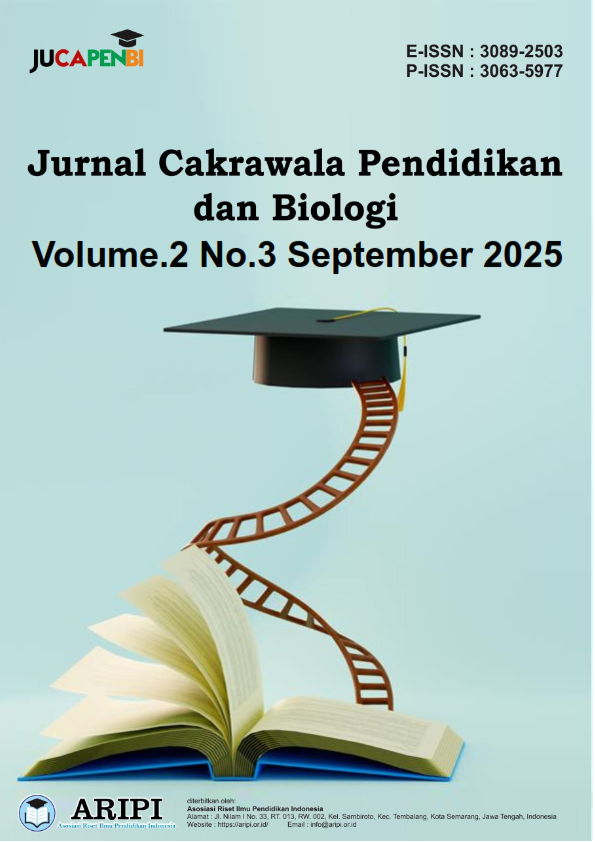Identifikasi Efektivitas Daun Pedada (Sonneratia Caseolaris) Sebagai Antimikroba dan Potensinya dalam Pengobatan Tradisional
DOI:
https://doi.org/10.61132/jucapenbi.v2i3.614Keywords:
Pedada leaves, antimicrobial, inhibition zone, Sonneratia caseolaris, bioactive compoundsAbstract
Pedada leaves (Sonneratia caseolaris), a type of mangrove plant that grows in tropical and subtropical coastal areas, have high ecological and pharmacological value. In addition to functioning as coastal protection from abrasion and seawater intrusion, this plant is also known to contain various secondary metabolite compounds such as flavonoids, tannins, saponins, and alkaloids. These compounds have been widely reported to have important biological activities, one of which is as an antimicrobial agent. This study aims to identify the effectiveness of pedada leaf ethanol extract in inhibiting the growth of pathogenic microorganisms, especially bacteria that cause infections. The extraction process was carried out using 96% ethanol solvent through the maceration method, namely soaking the material in the solvent for a certain time to optimally obtain active compounds. The obtained extract was then tested for its antimicrobial activity using the disc diffusion method against test bacteria, both Gram-positive and Gram-negative. The inhibition zone formed around the disc was measured as an indicator of the antibacterial effectiveness of the extract. The results showed that pedada leaf extract was able to produce inhibition zones with varying diameters depending on the concentration used. The higher the extract concentration, the larger the diameter of the inhibition zone formed. This indicates a positive relationship between extract concentration and its antibacterial strength. This activity is believed to originate from the ability of compounds such as flavonoids and tannins to damage bacterial cell walls or disrupt microbial metabolic processes. This study provides initial evidence that pedada leaves have potential as an environmentally friendly and sustainable source of natural antibacterials. This potential is highly relevant in efforts to develop alternative antibacterial materials based on local plants, especially amidst increasing bacterial resistance to synthetic antibiotics.
References
Ahmad, I., & Beg, A. Z. (2001). Antimicrobial and phytochemical studies on 45 Indian medicinal plants against multi-drug resistant human pathogens. Journal of Ethnopharmacology, 74(2), 113–123.
Anjarsari, I. R., & Suhartono, M. T. (2014). Aktivitas antibakteri ekstrak daun jati terhadap Escherichia coli dan Staphylococcus aureus. Jurnal Teknologi dan Industri Pangan, 25(1), 63–70.
Arifin, M., & Sari, Y. W. (2020). Uji aktivitas antibakteri ekstrak daun ketapang (Terminalia catappa) terhadap bakteri Escherichia coli dan Staphylococcus aureus. Jurnal Ilmu Kesehatan, 9(1), 45–50.
Dwidjoseputro, D. (2005). Dasar-dasar mikrobiologi. Jakarta: Gramedia.
Faruk, M., Djalil, M. A., & Alhady, S. T. (2020). Uji daya hambat ekstrak daun bakau (Rhizophora apiculata) terhadap pertumbuhan bakteri Escherichia coli dan Staphylococcus aureus. Jurnal Farmasi Galenika, 6(1), 47–54.
Handayani, D., Wahyuni, W., & Zulkarnain, Z. (2019). Uji daya hambat antibakteri ekstrak etanol daun salam terhadap Escherichia coli dan Staphylococcus aureus. Pharmacon: Jurnal Ilmiah Farmasi, 8(3), 311–318.
Harborne, J. B. (1987). Metode fitokimia: Penuntun cara modern menganalisis tumbuhan. Bandung: ITB Press.
Kusumawati, I., & Yuliani, N. (2015). Uji aktivitas antibakteri ekstrak daun jambu biji terhadap Escherichia coli dan Staphylococcus aureus. Jurnal Ilmu Kefarmasian Indonesia, 13(1), 22–27.
Lestari, D., & Fadhilah, F. (2020). Potensi antibakteri ekstrak daun bidara (Ziziphus mauritiana) terhadap Escherichia coli dan Staphylococcus aureus. Jurnal Riset Kefarmasian Indonesia, 3(2), 122–128.
Mulyani, S., & Nugraha, R. (2022). Aktivitas antibakteri ekstrak etanol daun salam (Syzygium polyanthum) terhadap bakteri Staphylococcus aureus dan Escherichia coli. Jurnal Penelitian Sains, 24(1), 14–20.
Nuraini, R., & Sudarsono, S. (2019). Aktivitas antibakteri ekstrak daun pedada (Sonneratia caseolaris) terhadap bakteri Gram positif dan Gram negatif. Jurnal Biologi Tropis, 19(3), 330–338.
Prasetyo, B. C., & Inorah, I. (2013). Teknik pengolahan simplisia daun binahong (Anredera cordifolia). Jurnal Ilmiah Kesehatan, 5(1), 20–25.
Putri, R. D., & Cahyono, B. (2017). Aktivitas antibakteri ekstrak daun bakau (Avicennia marina) terhadap pertumbuhan Escherichia coli. Jurnal Biologi dan Pembelajarannya, 4(2), 89–94.
Rahayu, W. P., & Nugroho, R. A. (2020). Uji aktivitas antibakteri dari daun ketapang (Terminalia catappa L.) terhadap pertumbuhan bakteri. Jurnal Kimia Valensi, 6(2), 154–160.
Sari, I. P., & Sulastri, D. (2021). Uji daya hambat ekstrak daun mangrove terhadap Escherichia coli dan Staphylococcus aureus. Jurnal Farmasi dan Ilmu Kefarmasian Indonesia, 8(1), 17–25.
Yuliani, N., & Anggraini, D. (2018). Aktivitas antibakteri flavonoid terhadap bakteri patogen. Jurnal Biologi, 7(2), 103–110.
Downloads
Published
How to Cite
Issue
Section
License
Copyright (c) 2025 Jurnal Cakrawala Pendidikan dan Biologi

This work is licensed under a Creative Commons Attribution-ShareAlike 4.0 International License.






